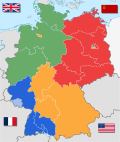| State of BrandenburgLand Mark Brandenburg (1947) Provinz Mark Brandenburg (1945–1947) | |||||||||||||||||||
|---|---|---|---|---|---|---|---|---|---|---|---|---|---|---|---|---|---|---|---|
| |||||||||||||||||||
| 1947–1952 | |||||||||||||||||||
 Flag
Flag
 Coat of arms
Coat of arms
| |||||||||||||||||||
 Brandenburg within Allied-occupied Germany in 1947 | |||||||||||||||||||
 Comparison of the country borders of 1947 (violet) and 1990 (red); since 1990 the State of Berlin covers the Greater Berlin area. | |||||||||||||||||||
| Capital | Potsdam | ||||||||||||||||||
| Area | |||||||||||||||||||
| • 1950 | 27,612 km (10,661 sq mi) | ||||||||||||||||||
| Population | |||||||||||||||||||
| • 1950 | 2,725,000 | ||||||||||||||||||
| Government | |||||||||||||||||||
| First Secretary of the Socialist Unity Party | |||||||||||||||||||
| • 1946–1948 | Willy Sägebrecht and Friedrich Ebert Jr. | ||||||||||||||||||
| • 1948–1949 | Willy Sägebrecht and Paul Bismark | ||||||||||||||||||
| • 1949–1952 | Willy Sägebrecht | ||||||||||||||||||
| Minister-President | |||||||||||||||||||
| • 1945–1949 | Karl Steinhoff | ||||||||||||||||||
| • 1949–1952 | Rudolf Jahn | ||||||||||||||||||
| Legislature | Landtag of Brandenburg | ||||||||||||||||||
| Historical era | |||||||||||||||||||
| • Established | 9 July 1947 | ||||||||||||||||||
| • Declaration as state | 6 February 1947 | ||||||||||||||||||
| • Abolition of Prussia | 25 February 1947 | ||||||||||||||||||
| • State of East Germany | 7 October 1949 | ||||||||||||||||||
| • Disestablished | 25 July 1952 | ||||||||||||||||||
| |||||||||||||||||||
| Today part of | Germany | ||||||||||||||||||
The State of Brandenburg (German: Land Brandenburg) was a subdivision of the Soviet occupation zone (until 1949) and state of East Germany (from 1949) which corresponds widely to the present-day German state Brandenburg. The state was originally formed as administrative division Province of March Brandenburg (Provinz Mark Brandenburg) by the Soviet Military Administration in Germany (SMAD) in July 1945, a re-establishment of the Prussian Province of Brandenburg, excluding the Eastern parts behind the Oder–Neisse line to Poland. With the abolition of Prussia in February 1947, it was named State of March Brandenburg (Land Mark Brandenburg) but in June 1947 the SMAD forced to change the name to State of Brandenburg. In August 1945, a transfer of territory was ruled out between Allied-occupied Berlin. Compared to the administrative divisions of Nazi Germany, it comprised the Western part of the Gau March Brandenburg and small parts of Berlin.

Due to the post-war situation in Germany, the SMAD appointed state administrations in all subdivisions of their occupation zone in July 1945. Karl Steinhoff became the president of the state administration in Brandenburg and later was elected to the Minister-President. The first election for the Landtag of Brandenburg was held on 20 October 1946, on the same day the elections for the Landtage of the other divisions in the SBZ had been ruled out. The Soviet-backed SED (which became the ruling party of the GDR from 1949 onwards) received 43.5% of the votes, CDU 30.3%, LDPD 20.5% and VdgB 5.7%. In February 1947, the state-constitution was adopted. However, all resolutions by the parliament were made subject to approval of the SMAD.
After the foundation of the German Democratic Republic (GDR) in October 1949, a second election for the Landtag was held in October 1950. The only party was the National Front, an alliance of political parties and mass organisations controlled by the SED, which received 99.9% of the votes. Following this election, it became the first and only time that five members of the Landtag were sent to the Chamber of States of the GDR. As the ruling communists aimed to build a quasi-unitary state, the state was dissolved by a change of the Constitution of East Germany in July 1952. All of the five Länder were replaced by 14 newly formed Bezirke. In case of Brandenburg, the territory was transferred to the Bezirke Cottbus, Frankfurt, Neubrandenburg, Potsdam and Schwerin. The abolishment of the Chamber of States in 1958 and two ratifications of the constitution in 1968 and 1974 finally eliminate all kinds of federalism in the GDR until the peaceful revolution in 1989. After the first free elections in the GDR, the five Länder were re-established with some smaller geographical adjustments in August 1990 to accede to the Federal Republic of Germany.
Minister President (1945–1952)
| Portrait | Name (Born–Died) |
Term of office | Political party | |||
|---|---|---|---|---|---|---|
| Took office | Left office | Days | ||||
| 1 | 
|
Karl Steinhoff (1892–1981) |
20 December 1946 | 5 December 1949 | 1081 | Social Democratic Party (until 1946) Socialist Unity Party (from 1946) |
| 2 | 
|
Rudolf Jahn (1906–1990) |
5 December 1949 | 23 July 1952 | 961 | Socialist Unity Party |
| From 23 July 1952 until 3 October 1990, State of Brandenburg was abolished. | ||||||
References
- "Landtagswahlen Brandenburg". wahlen-in-deutschland.de. 25 October 2014. Retrieved 8 June 2017.
- "Verfassung für die Mark Brandenburg". verfassungen.de. 6 February 1947. Archived from the original on 4 March 2016. Retrieved 8 June 2017.
| Allied-occupied Germany (1945–1949/1956/1990) | ||
|---|---|---|
| American Zone |  | |
| British Zone | ||
| French Zone | ||
| Soviet Zone | ||
| Berlin (1949–1990) |
| |